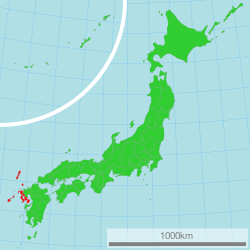Search Jobs
Sorry, we couldn't find any results.
Please try different search terms.
 Located on the western tip of Kyushu with excellent natural ports, Nagasaki holds a unique place in Japanese history and culture. Initially it was a gateway to trade with the Asian mainland and later served as the primary point of contact with Europe via Portuguese traders and the Catholic missionaries who accompanied them. As such a unique cosmopolitan culture took root and began an evolution that is still present today. Along the way, however, Nagasaki was hit twice with massive tragedy. First, was the persecution of Christians in the early 1600s when tens of thousands of them were executed and many more forced to hide their beliefs. Three centuries later, unclear skies over Kokura City sealed Nagasaki's fate to a nuclear holocaust on August 9, 1945 when as many as 80,000 of its citizens would perish. The Japanese are a robust people known for their resilience, and this is more evident in Nagasaki than any place else as the area has recovered from one calamity after another.
Located on the western tip of Kyushu with excellent natural ports, Nagasaki holds a unique place in Japanese history and culture. Initially it was a gateway to trade with the Asian mainland and later served as the primary point of contact with Europe via Portuguese traders and the Catholic missionaries who accompanied them. As such a unique cosmopolitan culture took root and began an evolution that is still present today. Along the way, however, Nagasaki was hit twice with massive tragedy. First, was the persecution of Christians in the early 1600s when tens of thousands of them were executed and many more forced to hide their beliefs. Three centuries later, unclear skies over Kokura City sealed Nagasaki's fate to a nuclear holocaust on August 9, 1945 when as many as 80,000 of its citizens would perish. The Japanese are a robust people known for their resilience, and this is more evident in Nagasaki than any place else as the area has recovered from one calamity after another.
After the war, Nagasaki City and nearby Sasebo rebuilt themselves as port cities with industry centered on shipbuilding. Nagasaki prefecture has a population of 1.3 million with more than half of these people living in the two largest cities of Nagasaki and Sasebo. Electronic parts, fisheries, tourism and ceramics comprise other parts of the economy. There are about 40 English conversation schools in Nagasaki that employee native English speakers and half as many other educational institutions that may hire foreign teachers.
Nagasaki Peace Park, a memorial to the atomic bombing, may be the most visited place in Nagasaki. Other points of interest in Nagasaki include: Nagasaki Museum of History, the Prefectural Art Museum, Glover Garden (related to the 19th century trader of the same name), Huis Ten Bosch (Dutch-themed amusement park), Shinchi Chinatown, Mount Inasa with spectacular view of Nagasaki City, Meganebashi Bridge, Gunkanjima (an abandoned island off Nagasaki's coast)
On the histocial side, Shimabara Castle and Hirado Castle are impressive castles. Other sites include Dejima (a former district reserved for Dutch traders) and 26 Martyrs Monument. Then, there are a variety of churches, temples and shrines to see, including Oura Church (the most famous church in Japan), Urakami Cathedral (destroyed in the atomic bomb blast), Confucius Shrine, Suwa Shrine , Sofuku-ji Obaku Zen temple, Kofuku-ji, Sofuku-ji. Finally, Arita and Imari are two of the famous pottery areas in Japan.
Kunchi (or Okunchi) is the most popular festival in Nagasaki. It began as a harvest festival in the 1500s and later became a Shinto festival associated with the Suwa Shrine. Featuring a dragon dance, it is held from October 7-9 every year and depicts Nagasaki's colorful history in a variety of presentations. The Nagasaki Lantern Festival, which celebrates the Chinese New Year, is held from February 18 to March 4.
Chanpon (literally, "mixing a vareity of things") is the most well known Nagasaki cuisine, which is a type of ramen. It is made by frying pork, seafood and vegetables with lard and then adding them to a soup made with chicken and pig bones and having specially made ramen noodles. A chain of chanpon restaurants, "Ringer Hut," which has immortalized the name of Thomas Ringer, a 17th century Nagasaki merchant, is located throughout Japan. Other Nagasaki cuisine includes: Pork belly and Shippoku Ryori, Sasebo Burger, Nagasaki beef, guzouni, sara udon, Toruko rice, castella, etc.
